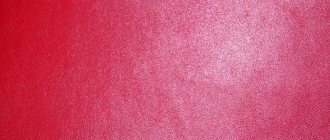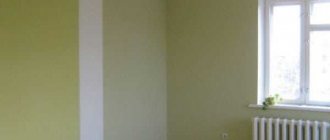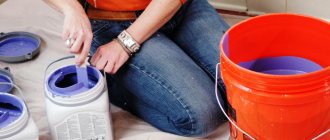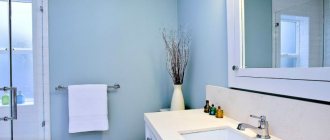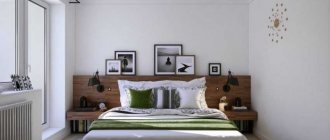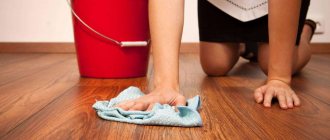Paint is one of the simplest and most effective interior design options. To use this building material, no special equipment or professional skills are required. In the modern paint and varnish industry, there are a huge number of varieties of wall paints. On the one hand, this is good, and the client has the opportunity to choose from a really wide range. On the other hand, because of this diversity, customers who are not familiar with the subject of paints and varnishes have difficulties and confusion when choosing.
Types of wall paints by composition
We have prepared this article to provide the necessary information in clear language to a person who is faced with the need to choose paint for painting the walls of a house, apartment or, for example, office for the first time. First of all, let's look at the types of paint composition.
Water-based paints for walls
Water-based - (also known as water-dispersion, water-dispersed, aqueous) are paints in which the main component is water. Various additives and components are added to it. The principle of operation is quite simple - when applied to the surface, the water evaporates and the remaining components dry out. A durable polymer film is formed on the surface. The performance qualities of the film depend on the concentration of fillers and beneficial additives in the paint composition.
Water-based paints were developed relatively recently, in the 80s in Germany. The main reason for their appearance was that the alkyd and oil paints commonly used up to this point have a pungent odor. This makes them very inconvenient for indoor work. In addition, they are highly flammable, making storage and transportation difficult.
In turn, odorless, water-based wall paints are perfect for interior work. As for fire safety, you can safely extinguish an open fire with them if desired. Based on the type of fillers, water-based paints are divided into three main types: acrylic, rubber and silicone. Each type has its own area of application and features.
Acrylic
A type of water-based paint that uses acrylic latexes as a filler. Therefore they can also be called Latex and Acrylate. Acrylic wall paints are the most common type and are suitable for most types of mineral, metal and wood substrates. They are used both by professional builders and for DIY repairs. Quite decent characteristics for an affordable price.
Preferred surfaces: wood, concrete, stone, drywall.
Advantages: relatively low cost, good wear resistance, quick drying, no odor, good moisture resistance, environmental friendliness, fire safety, large selection of colors for tinting.
Disadvantages: average vapor permeability, average elasticity.
Rubber
An additional property included in rubber paints is increased elasticity (crack resistance). Dried paint resembles a rubber film that can be rolled or stretched. At the same time, no visible defects or cracks will appear on it. Due to this property, rubber water-based paints are also called crack-resistant .
Preferred surfaces: wood, concrete, stone, drywall.
Advantages: increased elasticity, waterproofing, high wear resistance, absence of unpleasant odor, environmental friendliness, fire safety, large selection of colors for tinting.
Disadvantages: higher cost, low vapor permeability.
Silicone
The main advantage of this material is increased vapor permeability. At the same time, the paint is not afraid of moisture and wet abrasion. The material is ideal for application to the facades of buildings made of porous materials such as foam concrete and aerated concrete. However, it can also be used in interior wall decoration. The painted surface is wash-resistant.
Preferred surfaces: foam concrete, aerated concrete, other porous materials.
Advantages: increased vapor permeability, hydrophobicity, high wear resistance, absence of unpleasant odor, environmental friendliness, fire safety, large selection of colors for tinting.
Disadvantages: high cost, average elasticity.
Organic
Organic (organic-soluble, organic solvent based) are paints that are based on solvents instead of water - white spirit, solvent, xylene, gasoline or turpentine. As mentioned above, this type of paint is less often used for finishing walls in interiors due to the unpleasant odor, harmful fumes and fire hazard. However, for walls made of wood or metal, it is better to use organic paints.
They are also divided into two subtypes according to the type of film-forming substance in the composition - natural and alkyd drying oils.
Alkyd
They are made on the basis of artificial alkyd drying oils. Due to good adhesion to the base and the absence of water in the composition, they are suitable for protecting metal surfaces from corrosion. More expensive than oil paints, but more resistant to mechanical stress, light and washing.
Preferred surfaces: wood, metal.
Advantages: versatility, high wear resistance, quick drying, good moisture resistance.
Disadvantages: low light fastness, poor elasticity, unpleasant odor, fire hazard.
Oily
They are made on the basis of natural drying oils obtained from vegetable oils: linseed, hemp, sunflower. Drying oil acts as a binding component for fillers. Talc, barite, and barium sulfate are used as fillers.
Preferred surfaces: wood.
Advantages: relatively low cost.
Disadvantages: long drying time, harmful fumes, unpleasant odor, flammable.
Oil coloring mixtures
Oil-based materials contain natural oils. This is their difference between water-based paints, which dissolve with water.
Use of oil dyes
- This distinctive feature means that the oil composition takes a very long time to dry and then releases a specific odor. It lasts for some time and is impossible to get rid of. Until recently, this property had no effect on its popularity among consumers. It’s just that before people didn’t have much of a choice, so they used oil paints not only for exterior decoration, but also for interior painting of walls and metal elements.
- In the modern world, the range of painting products on construction markets is quite wide and people have stopped using oil paints for interior decoration.
- The advantage of such compositions is resistance to wear, and the cost is low. If the surface has previously been painted, it will not be necessary to re-paint it soon.
- The main disadvantage is that the material does not allow air to pass through and, with further use, the top layer of finish may peel off.
Paintable surface options
Painting work is performed at the end of the renovation. In this case, the main tasks of painting a wall are:
- protection of the wall material from destruction, increasing service life;
- improving the sanitary and hygienic condition of the premises;
- decorative design of the interior and exterior of the building.
You can get the desired result by performing several steps, which are not limited to selecting paint colors. It is necessary to select its type and performance properties for the surface to be painted - different paints interact differently with base materials. In this case, you need to start from the type of room and the requirements for the final durability of the coating.
Also, the quality of the work performed is directly influenced by the correct preparation of the surface for painting. We should not forget about the technology of applying the material to previously painted or new surfaces - violation of the manufacturer’s instructions can lead to film cracks, peeling, etc. In 60% of cases, a poor result is obtained with an insufficiently prepared surface.
Concrete
The concrete base collects dust well, which does not look very aesthetically pleasing and makes it difficult to restore final order in the apartment after renovation. Therefore, 90% of it is covered with paint. For this purpose, acrylic and alkyd paints are mainly used - almost any of the listed options are suitable for treating concrete indoors. Alternative options are decorating with plaster or clear varnish if the interior design is planned with untreated concrete walls.
Before painting, the surface should be dust free using a transparent primer. After treatment, the pores of the concrete will be filled with primer, which will allow the paint to lay down in an even, dense layer. This will also reduce the consumption of base material.
Drywall
Plasterboard structures must be prepared before painting: putty and sand. Painting compounds cannot be applied directly to drywall sheets. Finishing can be done with any paint, but the best results are obtained by using water-based paints.
Plaster
Plastered walls provide texture and can be painted without additional putty. You can start finishing the plaster only after it has completely dried and it is best to use water-based paints. To ensure high-quality adhesion of the composition to the base, it is primed several times. In rooms with a lot of moisture, the plaster is treated with an antifungal agent before painting.
Brick
Brick in the interior and exterior itself looks good, but if you decide to paint it, know that you will have to repeat the procedure constantly, at intervals of 5-6 years. Brick “breathes”, and efflorescence, stains and chips periodically appear on its surface.
Before painting, the brick must be well prepared: remove stains, wash the surface with soap, and fill any imperfections. Acrylic paints are suitable for painting brick indoors. The main thing is to thoroughly prime the brick wall before starting work. It is better to process brick with a brush, since the material absorbs a lot of paint.
General recommendations
Below are tips on how to choose the best and most durable models.
- If you are using it to decorate a child’s room, then the original option would be to choose slate paint. Gives potential for creativity. The child will draw and wash off pictures on the walls. The kids will love it.
- If the room has high humidity and temperature changes, it is better to choose silicone or silicate, it shows high quality in aggressive environments.
- If you are taking it for a bedroom or for a room with little dirt, choose latex ones. They do not tolerate wet cleaning; if washed frequently, they will lose color and appearance.
- Purchase. There are two options: choose directly from a hardware store or order online. It’s hard to say for sure where to buy it. The main thing is to check the expiration date and the tightness of the packaging before purchasing.
Type of room to be painted
The choice of painting material for wall decoration primarily depends on the type of room where the painting work will be carried out. The interior of each room is individual, and the choice of material for painting requires solving specific problems. In addition, rooms may have different humidity, intensity of use, lighting and other factors. In some places, painted walls should be easy to clean and wash, while in others they should be sufficiently resistant to dry abrasion. In any case, the painted surface should look aesthetically pleasing no matter what room they are in.
We have collected several tips for the main types of premises, which, if followed when decorating the walls, will ensure a good result.
Children's room
Painting walls in a children's room has advantages over other finishing options - wallpaper and plasters. At a minimum, it is much easier to clean the walls painted after the child’s “artwork”. The surface can be easily renewed if washing fails. Experts recommend updating the walls in the nursery every 2-3 years.
Moisture-resistant or washable acrylic paints are best suited for children's rooms. They have increased resistance to washing, are environmentally friendly and easy to use. In addition, they do not leave any unpleasant odors after repairs.
Bathroom
In the bathroom, wall decoration has its own characteristics. Thus, places in contact with water (near the shower, sink, bathtub) should be covered with tiles or glass panels. Painting is permitted in other areas. Since excess moisture regularly appears in the room, it is better to choose washable acrylic or rubber paint.
Kitchen
Painting the walls in the kitchen allows you to create a modern and laconic design in the room. The choice of colors in kitchen design is an individual matter; here you need to take into account how the furniture is decorated, how artificial and natural light falls, as well as your personal taste preferences.
Keep in mind that since the walls in the kitchen often have to be wiped, the paint must withstand wet cleaning, and ideally, washing with brushes and cleaning products. Washable acrylic-based wall paints are best suited for this.
Corridor
The walls of the corridor are subject to abrasion, so the surface finish is subject to increased demands on wear resistance and the ability to withstand frequent cleaning and washing. The choice of color for the walls depends on the lighting in the room (often there is no natural light in the corridor). In a small area it is better to use light colors - they expand the space. Acrylic paint is also suitable for the corridor.
Hallway
In the hallway, as in the corridor, wall coverings wear out faster than in other rooms. The walls will get dirty from contact with outer clothing and shoes. In addition to contamination, the surface suffers from mechanical damage, as many objects are moved through the hallway. Considering all the risks, it is better to use paint for walls that is resistant to friction, moisture, with an elastic effect, and without impurities harmful to health. Acrylic and rubber materials have these qualities.
Living room
According to design rules, all rooms of the home must be decorated in a single style, therefore, following the hallway, the living room is designed so that it is comfortable to be in. The color scheme is selected depending on the size of the room, lighting, and appearance of the furniture. In addition, using paints on the walls, you can divide the living room into different functional areas. Since the finishing does not have high requirements for wear resistance and water resistance, moisture-resistant wall paints can be used for painting.
Bedroom
Before painting your bedroom walls, you need to think carefully about the color scheme. The fact is that the color of the walls should have a calming effect, moderately relaxing, so that in the morning you can easily get up after sleep. At the same time, you should correctly select a combination of cold and warm shades and the degree of gloss. The walls in the bedroom should be discreet and at the same time pleasing to the eye. As for the type of paint, you can take washable wall paints or water-based dry abrasion resistant compositions, since the bedroom rarely has special requirements for the durability of the coating.
Production room
The color design of a production facility should perform a number of functions:
- smooth out the unpleasant sensations of workers from being in a space with incorrect proportions;
- correct the perception of heat and cold using colors;
- improve the results of mental-visual work during technological processes.
Rational design of production premises increases labor productivity. We recommend choosing wall paint based on the surface material. These can be oil or acrylic compositions - strong and durable. Before applying them, the substrate for painting should be well prepared.
Warehouse space
When choosing a finishing material for painting a warehouse, we recommend choosing cool colors and their shades. This solution has a number of advantages:
- does not irritate the eyes;
- expands the space;
- hides dust and dirt;
- fills the room with light.
In large warehouses, you can paint the walls by sector, depending on the goods stored, which will improve the orientation of workers and customers among product groups. For warehouses, it is necessary to take material that is not afraid of temperature changes, does not contain solvents, does not burn, dries quickly and does not become dirty.
Office
Employees spend a lot of time in the office, so everything in the room should be aimed at efficient work. This includes the color of the finish, the arrangement of objects in the interior, furniture, etc. A correctly selected color scheme increases productivity and does not cause fatigue or irritability. Psychologists recommend using green and blue tones for the office; grey, yellow, brown and even red are suitable. According to technical characteristics, the paint should not have any odor, but it should be easy to clean and wash. Acrylic compositions meet all requirements.
| Room type | Smell | Durability | Material type |
| Children's | Without smell | Washable | Water based |
| Bathroom | Washable | ||
| Kitchen | Washable | ||
| Hallway | Washable | ||
| Production | Washable | ||
| Corridor | Moisture resistant | ||
| Living room | Moisture resistant | ||
| Bedroom | Moisture resistant | ||
| Stock | Moisture resistant | ||
| Office | Resistant to dry abrasion |
Choosing a color
The color of painted surfaces is also important, since the entire area of the walls will now and then affect the people who are constantly in the room. So, let's start with the classic rule : if the room faces north and there is little light in it, then it is better to use light shades, if the room is south and bright, then you can use cold tones, and even bright colors, although they visually conceal the room. This leads to another rule: if the room is small, then light and pastel colors are perfect for it, which can even visually expand it a little - bright shades are only suitable for very spacious rooms or as an accent on one wall.
For the bedroom and living room, it is better to choose unobtrusive, calm colors: beige, light green, light brown, peach, etc. They are also suitable for a nursery, but there you can make the playing part a little brighter than the rest of the room. It is recommended to use shades of yellow in offices, since psychologists have proven that it has a positive effect on creative activity, and in kitchens – shades of red or lighter and more discreet colors, especially if the kitchen is small.
For traditionally small rooms , such as the hallway, bathroom and kitchen, it is better to choose a dull paint: light shades of orange, apricot, yellow, beige, milky brown, etc. In any case, before purchasing the required amount of paint, you need to think carefully about the overall concept of the interior: what color will the furniture, curtains, and other decorative elements be, how will it all fit together, will it look organic, etc.
A good idea to diversify the interior would be to choose two shades of paint , but this is a rather difficult question, since you need to correctly combine not only paint colors, but also choose them correctly for the interior, which is difficult even for some designers. We will omit the issues of difficulties in painting for now. So, you can choose the easiest way in this case: paint one wall in a shade that is exactly different from the rest of the walls, for example, beige walls and light blue one wall. This could be the wall with the TV, at the head of the bed, etc., depending on which room is being renovated. You can create entire compositions and drawings, patterns on one wall in several colors: if the wall itself will be an accent in the interior, then you need to select paints that have a clear contrast with each other, but if the task is simply to decorate the wall in an interesting way, then you can combine colors that are similar in the palette .
Please note that the paint in the store will look a little different under their lighting than in the room, so it makes sense to do a test and see if you are happy with the resulting shade.
Important Specifications
Any paint on the packaging contains information about what it is intended for (exterior, interior, facade, interior work; waterproof, wear-resistant). And these are not all the characteristics.
The following parameters are determined in laboratory conditions:
- degree of gloss;
- resistance to washing and mechanical stress;
- consumption, hiding power;
- drying time;
- adhesion;
- lifetime;
- thixotropy;
- environmental friendliness;
- light fastness;
- weather resistance, etc.
Information on technical characteristics helps you choose the right material for high-quality wall finishing in different rooms.
Gloss level of coating
The ability of paint to reflect light (shine) is called gloss. The degree of gloss is measured in production by instruments - gloss meters, which determine the amount of light reflected from the surface. Glass has a standard reflection (gloss level 100 units), and this paint indicator is determined as a percentage in relation to the glass indicators. Manufacturers indicate the established degree of gloss on the packaging using alphabetic or numerical symbols (for example, M - matte, PM - semi-matte, GM - deep matte). In numbers, this data is recorded with signs from 0 to 100 (for example, information on a can of 90-100 says that it contains paint with the highest gloss).
The gloss in the finish reveals the smallest defects on the surface, and this requires high quality preparation before painting, so we recommend using matte paints for walls.
Resistance to washing and mechanical stress
These are also important indicators of paint, and for latex wall paints they depend on the number of binding components per unit volume - latex and acrylic polymers. The test material is applied to the surface with a thickness of 25 microns and 200 passes are made with a wet brush, then the thickness of the lost layer is measured. The abrasion resistance rating is indicated on the packaging.
Additional properties
In addition to basic information about the composition of the paint, manufacturers indicate additional indicators that help select materials for finishing certain rooms.
Consumption
If we are talking about a water-based coating, then its consumption when finishing walls is approximately 150–200 g/m2 when applying one layer. To paint the surface well, you have to apply at least two layers. The number of passes depends on how the surface being treated absorbs the material. To correctly calculate the amount of paint, it is necessary to take into account the density of the material - how many kilograms are contained in one liter. For our water-based wall paints this figure is 1.4 kg/l.
Drying time
Buyers always pay attention to the drying time of the material. Different compositions dry differently - from 2 to 24 hours. Drying time depends on air temperature and humidity (optimal parameters +20 ° C at 65% humidity). The final polymerization of the paint applied to the surface and the acquisition of all specified properties occur within 7-14 days after application.
Covering power
The hiding power index is closely related to the paint consumption characteristics, since it determines the ability to hide the color of the base during application. Measured in grams of dried material required to cover one square meter of substrate for the original color to completely disappear from it. The indicator depends on the ratio of the filler, pigment and binder (particle size, quantity, etc.). High coverage rates guarantee low consumption.
Lifetime
The shelf life of ODISSEY coloring compositions is 24 months from the date of manufacture, provided that the materials are stored in accordance with storage recommendations. The exception is materials of class KM0 - for them the guaranteed shelf life is 6 months.
Adhesion
Indicator of adhesion of the composition to the treated surface. Adhesion is measured by the force of film separation from a unit area. Mechanical, chemical and electromagnetic forces of adhesion of the film to the surface are ensured by the introduction of special additives into the composition.
Review of manufacturers
The manufacturer Amourcolor produces high quality textured paints that are resistant to wear. Buyers are provided with 3 product options: Tactite with a suede surface or mosaic, Perlata with a pearl sheen and Escenta with a variety of undertones. All paints are water-based and environmentally friendly.
Domestic offers paints with various textures: embossed, “Mizuri”, “wet silk” and others. All products of high quality can be purchased at a competitive price.
The Russian company VGT has been producing paint and varnish products since 1992. It is possible to purchase various types of textured paints: facade and interior, water-based, crack-resistant.
The product is ideal for our climate. There are a lot of positive reviews about it. In the video below you can watch a master class from the manufacturer “VGT” on applying textured paint with the “Travertine” effect.
Manufacturer from France Blancolor supplies many types of durable materials for decorative wall decoration. Among them are translucent paint Essuyables, silk based on cellulose fibers Tradimurs, waxed plaster effect Effets Platre Cires and many other types.
Textured paints from the manufacturer Clavel have a variety of colors and perfectly imitate silk, brocade, and velvet on walls. There are different types of designs ranging from antique to modern. The composition uses environmentally friendly components.
How to paint walls correctly
Painting correctly is not difficult, you just need to take a few simple steps:
- choose the right paint;
- purchase related materials (gloves, masking tape, brush/roller/spray, primer, paint tray);
- qualitatively prepare the surface for finishing;
- apply paint carefully.
The surface must be clean, level and dry. To do this, you need to clean the wall of old material if it was previously painted. If this is wallpaper, then you should remove it with a spatula, sand the old flaking paint to a clean base. Fill cracks and chips with starting and then finishing putty and sand with sandpaper.
Then a layer of primer should be applied (the primer ensures good adhesion of the paint to the wall and removes dust from the surface). On a new wall, which itself is smooth and has no defects, a simple primer is sufficient.
The paint should also be prepared - stirred using a drill attachment or screwdriver. This is necessary for uniform consistency of the material. After long-term storage, the fillers in the composition settle to the bottom, as a result of which the paint in the upper layers is less thick than at the bottom. If necessary, the material can be diluted with water or a solvent (information about the diluent and acceptable dilution proportions is usually indicated on the packaging).
For painting, use a roller, brush or spray gun. The diluted composition is poured into the tray in small portions and the roller is dipped into it, rolled out on a special section of the tray to remove excess material from the roller, and then rolled out along the wall. Painting in rooms should begin on the wall farthest from the exit. In narrow areas (at the junction with windows, ceiling) they work with a small brush, large areas are treated with a roller. Using a brush and roller, rub the material well and roll it so that there are no smudges or missing spots left on the surface.
The packaging indicates how many layers must be applied to obtain the result. If the material is applied in two or more layers, be sure to wait until the first one dries so as not to reduce the quality of the paint. Work carefully, try not to paint over skirting boards, cornices, and windows adjacent to the walls. You can use masking tape to protect them. After finishing work, be sure to wash your brushes, roller and tray.
Remove or protect anything that gets in the way
Before starting work, you need to remove everything unnecessary from the room and protect surfaces that will not be painted from splashes.
Take out the furniture and all other items, and place what cannot be removed in the middle of the room and cover it with film. Wrap the heating radiators with it or remove them. Cover the floors with thick film or several layers of newspapers.
Illustration: Artyom Kozoriz / Lifehacker
Turn off the power to sockets and switches, remove their covers and cover them with masking tape. Also cover the baseboards, platbands, edges of slopes and other adjacent surfaces so as not to splash them.
Color options
Painting walls has virtually unlimited possibilities for choosing colors, since paints can be tinted in the desired color to create a unique interior design. White paints for walls are far from the only solution, thanks to tinting. Correctly selected primary colors and shades will delight you for a long time and evoke only positive emotions. In design, when painting walls, several basic combinations are used:
- gradient combination of shades of the same color;
- a range of similar shades;
- contrasting combinations of different colors.
When making a choice in favor of one color scheme or another, it is necessary to take into account a number of points, among which the purpose of the room, its size, the desire to visually expand or reduce the space, and the lighting of the walls play an important role.
When choosing a color scheme, it is also necessary to take into account the influence of color on the psychology of people who are constantly in this space, since colors affect us differently. Too bright ones can quickly get boring and, instead of harmony and calm, you can get depression, anxiety, and drowsiness.
Remember that the paint acquires its true color only after complete drying. Therefore, it is necessary to select colors and shades from catalogs, do preliminary coloring of samples, check them in room conditions in combination with furniture, accessories, and look at changes in shades under different lighting. When choosing a range of colors for painting walls, contact a professional designer - they will help you find a solution. We, in turn, provide samples and colors of our materials for construction projects.
Beautiful examples
To make the interior of the room look beautiful, stylish and pleasant, you can use a variety of effects. If you can’t come up with some interesting ideas on your own, you can find a suitable option on the Internet.
The use of bright colors is uncharacteristic for a bedroom, but skillful dilution of the main color with white furniture and a beautiful, discreet pattern by the bed allows you to get a stylish space in which everything is laconic and at the same time cozy.
For a living room or hall, you can use a large pattern, which allows you to make the space unusual and at the same time very cozy and pleasant. A floral theme is suitable for rooms where mainly women and girls live. To support bouquets, it would be very successful to purchase furniture with the same colors
A contrasting floor or carpet allows you to evenly distribute attention throughout the room
For the bathroom, you can use circles of different sizes and colors, which will help make the room more bright and positive. To support this decor, you can purchase a bath curtain with a similar print.
A variety of abstractions with floral motifs will look great in the hall. You can do something similar in the bedroom, just choose calmer tones. But in the kitchen such painting should be done in bright and rich colors.
Any interior can be transformed, you need to know what to do with it, what techniques to use and what materials to use. This way any room will gain originality, beauty and comfort.
Work progress step by step
The instructions consist of the following steps that must be followed:
- Painting starts from the inner and outer corners. The walls are painted from top to bottom. Start work at the window that illuminates the room.
- Hard-to-reach surfaces are painted using thin brushes. Enamel varnish paint is suitable for processing baseboards. Cast iron batteries should not be processed; it is recommended to cover them with a decorative grille.
- The roller must be rolled over the painting grid, squeezing out excess paint. Then there will be no moisture left on the painted materials. Rollers go over one place two or three times. The stripes overlap each other by 30-50 cm.
- If the surface is large, then visually it is divided into several small squares. First, each square is painted with vertical stripes, with horizontal stripes on top. The next square covers the previous one by half the length of the roller. The paint is distributed evenly over the surface.
Examples of finished works
Gradients with transitions from one scale to another look good.
But monochromatic options also attract attention.
Different bases - different effects.
Useful tips
Let's look at some useful tips that will allow you to carry out all the necessary work correctly:
- For painting, be sure to buy a narrow brush. With its help, you can touch up small areas that you might have missed during the main painting (a common problem for novice craftsmen).
- Do not mix paints and varnishes with each other. Paint components may “conflict” with each other, so the physical properties of the mixture will be difficult to predict.
- If the paint has peeled off in a small area, it is enough to touch up the damaged fragment, but a full repair does not need to be carried out. Therefore, it is recommended to buy coloring compounds with a small margin.
Required Tools
Necessary tools
For painting, in addition to the paint and varnish materials themselves, the master will need the following tools:
- To remove the old coating - a rag, spatula, water, solvent (only for removing acrylic or oil coating).
- For finishing and leveling walls - a spatula, sandpaper, gypsum-based putty + water and a container for preparing the mixture.
- Directly for painting - a small container for pouring paint, a wide and narrow brush, a roller, a solvent (only for some paints).
